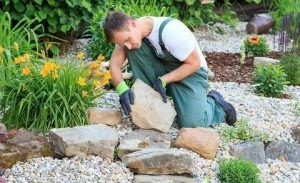
Landscape maintenance typically involves a range of tasks and services to keep outdoor spaces well-maintained and visually appealing. Here are some common activities included in landscape maintenance:
Lawn Care:
Lawn care is an essential aspect of landscape maintenance, and it includes various activities aimed at keeping the grass healthy, vibrant, and well-maintained. Here are some common lawn care activities included in the care of the landscape:
- Mowing: Regularly mowing the lawn at the appropriate height helps to maintain its health and appearance. The frequency and height of mowing may vary depending on the type of grass and the season.
- Edging: Edging along sidewalks, driveways, and other landscape borders helps to create clean and defined edges, enhancing the overall appearance of the lawn.
- Trimming: Trimming refers to cutting back overgrown grass along fences, walls, trees, and other landscape features that are difficult to reach with a lawnmower. It helps to maintain a neat and tidy look.
- Weed Control: Removing weeds from the lawn is crucial for maintaining its health and appearance. This can be done manually by hand-pulling or using appropriate herbicides or weed control products.
- Aeration: Lawn aeration involves creating small holes in the soil to allow better air, water, and nutrient penetration into the root zone. This helps to alleviate soil compaction and promote healthier grass growth.
- Overseeding: Overseeding involves spreading grass seeds over existing grass to fill in thin or bare areas. It helps to improve the density and overall health of the lawn.
- Fertilization: Applying appropriate fertilizers at the right time helps to provide essential nutrients to the grass, promoting healthy growth, color, and resilience.
- Watering: Proper watering is essential for maintaining a healthy lawn. It involves providing adequate water to the grass, taking into account factors such as grass type, weather conditions, and soil moisture levels.
Plant Care:
Plant care is an essential part of landscape maintenance and involves various activities aimed at ensuring the health, growth, and beauty of plants in the landscape. Here are some common activities included in plant care:
- Watering: Providing adequate water to plants is crucial for their survival and growth. The watering requirements may vary depending on the type of plants, weather conditions, and soil moisture levels. Regular and consistent watering helps to keep plants healthy.
- Pruning and Trimming: Pruning involves selectively removing dead, damaged, or overgrown branches or foliage from plants. This helps to improve their shape, promote new growth, and maintain their overall health. Trimming refers to cutting back or shaping plants to maintain their desired size and form.
- Fertilization: Applying fertilizers http://sbevolutionlandscape.com provides plants with essential nutrients necessary for their growth and development. It helps to replenish soil nutrients and promote healthy foliage, flowers, and fruit production. Fertilizers can be organic or synthetic, and the type and timing of application depend on the specific plant’s needs.
- Mulching: Applying a layer of mulch around plants helps to conserve moisture, suppress weed growth, and regulate soil temperature. It also adds organic matter to the soil as it decomposes, improving its fertility and structure.
- Disease and Pest Control: Monitoring plants for diseases and pests is crucial to prevent their spread and minimize damage. Regular inspection and timely intervention, such as using appropriate treatments or organic methods, help to keep plants healthy and free from infestations.
- Soil Maintenance: Maintaining healthy soil is vital for the overall health of plants. This includes activities like soil testing, amending with organic matter, and ensuring proper drainage to create optimal growing conditions.
Weed Control:
Weed control is an important aspect of landscape maintenance that involves various activities aimed at managing and preventing the growth of unwanted weeds. Here are some common activities included in weed control:
- Weed Removal: Regularly inspecting the landscape and manually removing weeds is a fundamental practice in weed control. This can be done by hand-pulling weeds or using handheld tools like a trowel or weed digger. It’s important to remove weeds from their roots to prevent regrowth.
- Mulching: Applying a layer of mulch around plants and in garden beds helps suppress weed growth by blocking sunlight and creating a barrier. Organic mulch, such as wood chips or straw, can also improve soil health as it breaks down over time.
- Pre-Emergent Herbicides: Pre-emergent herbicides are applied to the soil before weed seeds germinate. They create a barrier that inhibits weed seedlings from emerging, reducing the overall weed population. It’s important to apply pre-emergent herbicides at the right time and follow the product instructions carefully.
- Post-Emergent Herbicides: Post-emergent herbicides are used to control existing weeds that have already emerged. They are applied directly to the leaves or stems of the weeds and work by interfering with their growth or killing them. It’s important to select the appropriate herbicide for the specific weeds you are targeting and follow the instructions for safe and effective use.
- Cultural Practices: Maintaining a healthy and dense turf or planting bed can help prevent weed growth. Practices like proper mowing height, adequate watering, and regular fertilization can promote a dense and healthy lawn or plant cover, making it more difficult for weeds to establish and compete for resources.
- Landscape Design: Thoughtful landscape design can help minimize weed growth. Creating well-defined planting beds with proper spacing between plants and using ground covers or dense plantings can help reduce available space for weeds to grow.

Irrigation Management:
Irrigation management is a crucial component of landscape maintenance that involves the proper planning, installation, and maintenance of irrigation systems to ensure optimal water use and plant health. Here are some activities included in irrigation management:
- Design and Installation: Proper design and installation of an irrigation system is essential to ensure efficient and effective water distribution throughout the landscape. This involves determining the water requirements of different plant species, planning the layout of sprinkler heads or drip irrigation emitters, and installing the necessary pipes, valves, and timers.
- Watering Schedule: Developing an appropriate watering schedule is important to avoid under-watering or over-watering the landscape. Factors to consider when creating a watering schedule include plant types, soil type, weather conditions, and the specific water needs of different areas within the landscape. Adjustments to the watering schedule may be necessary during different seasons or periods of heavy rainfall.
- Monitoring and Adjusting: Regularly monitoring the irrigation system and its performance is crucial. This includes checking for leaks, clogged emitters, or malfunctioning valves. Adjustments may need to be made to the watering schedule or irrigation system settings based on changes in weather patterns, plant growth, or other factors that affect water requirements.
- Seasonal Adjustments: Different seasons require varying amounts of water for optimal plant health. Adjusting the irrigation schedule and duration based on seasonal changes helps prevent water wastage and promotes water-efficient practices. For example, reducing watering frequency during cooler periods or increasing it during hotter months.
- Water Conservation Measures: Implementing water-saving techniques can help minimize water waste and improve irrigation efficiency. This may include using rain sensors to prevent irrigation during periods of rainfall, installing moisture sensors to detect soil moisture levels and prevent over-watering, and using drip irrigation systems for targeted water delivery to plant roots.
Fertilization:
Fertilization is an essential aspect of landscape maintenance that involves providing necessary nutrients to plants to promote healthy growth and development. Here are some activities included in the fertilization process:
- Soil Testing: Before applying fertilizers, it is important to conduct a soil test to determine the nutrient levels and pH balance of the soil. This helps in identifying any deficiencies or excesses of specific nutrients and allows for more targeted fertilization.
- Fertilizer Selection: Based on the soil test results and the specific nutrient requirements of the plants in your landscape, appropriate fertilizers can be selected. Fertilizers come in different formulations, including granular, liquid, or slow-release options. Choosing the right fertilizer type and formulation ensures that plants receive the necessary nutrients in the appropriate amounts.
- Application Timing: Fertilizers should be applied at the right time to maximize their effectiveness. This may include applying fertilizers during the active growing season of the plants or based on specific plant requirements. It is important to follow the manufacturer’s instructions regarding the timing and frequency of fertilizer application.
- Proper Application Techniques: Applying fertilizers correctly is crucial to prevent issues such as nutrient imbalances or fertilizer runoff. It is essential to evenly distribute the fertilizer over the designated area and avoid direct contact with plant foliage or stems. Following recommended application rates and techniques helps ensure optimal nutrient uptake by the plants.
- Watering and Nutrient Absorption: After applying fertilizers, it is important to water the landscape adequately. This helps in the absorption of nutrients into the root zone and prevents nutrient leaching. Watering immediately after fertilization also reduces the risk of fertilizer burn on plants.
Pest and Disease Management:
Pest and disease management is an important aspect of landscape maintenance to protect plants from damaging pests and diseases. Here are some activities included in pest and disease management:
- Identification: Regular monitoring of plants is necessary to identify any signs of pests or diseases. Look for symptoms such as wilting, discoloration, holes in leaves, distorted growth, or presence of pests like insects or rodents.
- Integrated Pest Management (IPM): Adopt an integrated approach to pest management that combines multiple strategies to minimize the use of pesticides. This includes cultural, biological, and chemical control methods.
- Cultural Control: Implement cultural practices that promote plant health and reduce the risk of pest and disease problems. This includes proper watering, adequate fertilization, maintaining proper plant spacing, removing debris and fallen leaves, and practicing good sanitation.
- Biological Control: Encourage natural enemies of pests, such as beneficial insects, birds, or predatory nematodes, to control pest populations. This can be achieved by providing habitat and food sources for beneficial organisms, using biological control agents, or introducing natural predators.
- Chemical Control: If necessary, use pesticides as a last resort and in accordance with local regulations and guidelines. Select the appropriate pesticide based on the pest or disease being targeted, and follow the instructions on the label for safe and effective application. Consider using low-toxicity or organic pesticides whenever possible.